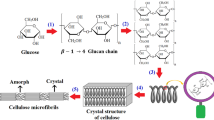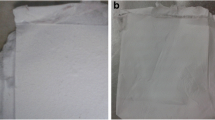Abstract
Antibiotic resistance of microorganisms is one of the major problems faced in the field of wound care and management resulting in complications like infection and delayed wound healing. Currently a lot of research is focused on developing newer antimicrobials to treat wounds infected with antibiotic resistant microorganisms. Silver has been used as an antimicrobial agent for a long time in the form of metallic silver and silver sulfadiazine ointments. Recently silver nanoparticles have come up as a potent antimicrobial agent and are finding diverse medical applications ranging from silver based dressings to silver coated medical devices. Chitin is a natural biopolymer with properties like biocompatibility and biodegradability. It is widely used as a scaffold for tissue engineering applications. In this work, we developed and characterized novel chitin/nanosilver composite scaffolds for wound healing applications. The antibacterial, blood clotting and cytotoxicity of the prepared composite scaffolds were also studied. These chitin/nanosilver composite scaffolds were found to be bactericidal against S. aureus and E. coli and good blood clotting ability. These results suggested that these chitin/nanosilver composite scaffolds could be used for wound healing applications.








Similar content being viewed by others
References
Gong P, Li H, He X, Wang K, Hu J, Tan W. Preparation and antibacterial activity of Fe3O4@Ag nanoparticles. Nanotechnol. 2007;18:604–11.
Klasen HJ. A historical review of the use of silver in the treatment of burns. II. Renewed interest for silver. Burns. 2000;26:131–8.
Castellano JJ, Shafii SM, Ko Donate FG, Wright TE, Mannari RJ. Comparative evaluation of silver-containing antimicrobial dressings and drugs. Int Wound J. 2007;4:114–22.
Fox CL, Modak SM. Mechanism of silver sulphadiazine action on burn wound infections. Antimicrob Agents Chemother. 1974;5:582–8.
Fox CL. Silver sulfadiazine: a new topical therapy for Pseudomonas in burns. Arch Surg. 1968;96:184–8.
Gemmell CG, Edwards DI, Frainse APJ. Guidelines for the prophylaxis and treatment of methicillin-resistant Staphylococcus aureus (MRSA) infections in the UK. J Antimicrob Chemother. 2006;57:589–608.
Furno F, Morley KS, Wong B, Sharp BL, Arnold PL, Howdle SM. Silver nanoparticles and polymeric medical devices: a new approach to prevention of infection? J Antimicrob Chemother. 2004;54:1019–24.
Ip M, Lui SL, Poon VKM, Lung I, Burd A. Antimicrobial activities of silver dressings: an in vitro comparison. J Med Microbiob. 2006;55:59–63.
Leaper DL. Silver dressings: their role in wound management. Int Wound J. 2006;3:282–94.
Feng QL, Wu J, Chen GQ, Cui FZ, Kim TN, Kim JO. A mechanistic study of the antibacterial effect of silver ions on Escherichia coli and Staphylococcus aureus. J Biomed Mater. 2000;52:662–8.
Sondi I, Salopek-Sondi B. Silver nanoparticles as antimicrobial agent: a case study on E. coli as a model for Gram-negative bacteria. J Colloid Interface. 2007;275:177–82.
Morones JR, Elechiguerra JL, Camacho A, Ramirez JT. The bactericidal effect of silver nanoparticles. Nanotechnology. 2005;16:2346–53.
Song HY, Ko KK, Oh LH, Lee BT. Fabrication of silver nanoparticles and their antimicrobial mechanisms. Eur Cells Mater. 2006;11:58.
Jain P, Pradeep T. Potential of silver nanoparticle-coated polyurethane foam as an antibacterial water filter. Biotechnol Bioeng. 2005;90:59–63.
Hu W, Chen C, Li X, Shi S, Shen W, Zhang Z, et al. In situ synthesis of silver chloride nanoparticles into bacterial cellulose membranes. Mater Sci Eng C. 2009;28:1216–9.
Maneerung T, Tokura S, Rujiravanit R. Impregnation of silver nanoparticles into bacterial cellulose for antimicrobial wound dressing. Carbohydr Polym. 2008;72:43–51.
Barud HS, Barrios C, Regiani T, Marques RFC, Verelst M, Dexpert-Ghys J, et al. Self-supported silver nanoparticles containing bacterial cellulose membranes. Mater Sci Eng C. 2008;28:515–8.
Ong SY, Wu J, Shabbir MM, Mui-Hong T, Jia Lu. Devolopment of a chitosan-based wound dressing with improved hemostatic and antimicrobial properties. Biomaterials. 2008;29:4323–32.
Lu S, Gao W, Gu HY. Construction, application and biosafety of silver nanocrystalline chitosan wound dressing. Burns. 2008;34:623–8.
Paula MM, Vitorio Franco C, et al. Synthesis, characterization and antibacterial activity studies of poly-{styrene-acrylic acid} with silver nanoparticles. Mater Sci Eng C. 2009;29:647–50.
Jeon HJ, Kim S, Kim TG. Preparation of poly(-caprolactone)-based polyurethane nanofibers containing silver nanoparticles. Appl Surf Sci. 2008;254:5886–90.
Rujitanaroj P, Pimpha N, Supaphol P. Wound-dressing materials with antibacterial activity from electrospun gelatin fiber mats containing silver nanoparticles. Polymer. 2008;49:4723–32.
Guncem G, Cigdem AO, Sibel E, Fikret S, Djursun K, Birgul S, et al. Fatty acid-based polyurethane films for wound dressing applications. J Mater Sci: Mater Med. 2009;20:421–31.
Lee SB, Kim YH, Chong MS, Lee YM. Preparation and characteristics of hybrid scaffolds composed of β-chitin and collagen. Biomaterials. 2004;25:2309–17.
Jayakumar R, Nwe N, Tokura S, Tamura H. Sulfated chitin and chitosan as novel biomaterials. Int J Biol Macromol. 2007;40:175–81.
Maeda Y, Jayakumar R, Nagahama H, Furuike T, Tamura H. Synthesis, characterization and bioactivity studies of novel β-chitin scaffolds for tissue-engineering applications. Int J Biol Macromol. 2008;42:463–7.
Madhumathi K, Binulal NS, Nagahama H, Tamura H, Shalumon KT, Selvamurugan N, et al. Preparation and characterization of novel β-chitin–hydroxyapatite composite membranes for tissue engineering applications. Int J Biol Macromol. 2009;44:1–5.
Madhumathi K, Shalumon KT, Divya Rani VV, Tamura H, Furuike T, Selvamurugan N, et al. Wet chemical synthesis of chitosan hydrogel–hydroxyapatite composite membranes for tissue engineering applications. Int J Biol Macromol. 2009;45:12–5.
Jayakumar R, Prabaharan M, Reis RL, Mano JF. Graft copolymerized chitosan—present status and applications. Carbohydr Polym. 2005;62:142–58.
Janes KA, Fresneau MP, Marazuela A, Fabra A, Alonso MJ. Chitosan nanoparticles as delivery systems for doxorubicin. J Control Rel. 2001;73:255–67.
Jayakumar R, Reis RL, Mano JF. Synthesis and characterization of pH-sensitive thiol-containing chitosan beads for controlled drug delivery applications. Drug Deliv. 2007;14:9–17.
Jayakumar R, Reis RL, Mano JF. Phosphorous containing chitosan beads for controlled oral drug delivery. J Bioact Compat Polym. 2006;21:327–40.
Lee YM, Kim SS, Park MH, Song KW, Sung YK, Kang IK. β-Chitin-based wound dressing containing silver sulfurdiazine. J Mater Sci: Mater Med. 2000;11:817–23.
Campos MGN, Henry RR, Lucia H, Innocentini M, Neera S. In vitro gentamicin sustained and controlled release from Chitosan cross-linked films. J Mater Sci: Mater Med. 2009;20:537–42.
Demling RH, DeSanti L. Effects of silver on wound management. Wounds. 2001;13:4–9.
Katrin K, Yang W, Harald K, Perelman LT, Itzkan I, Dasari RR. Single molecule detection using surface enhanced Raman scattering. Phys Rev Lett. 1997;78:1667–70.
Jaya J, Sumit A, Jyutika M, Rajwade, Pratibha O, Sanjeev K, and Kishore MP. Silver nanoparticles in therapeutics: development of an antimicrobial gel formulation for topical use. Mol pharm A. doi:10.1021/mp900056g.
Shih MF, Shau MD, Chang MY, Chiou SK, Chang JK, Cherng JY. Platelet adsorption and hemolytic properties of liquid crystal/composite polymers. Int J Pharm. 2006;327:117–25.
Jayakumar R, Egawa T, Furuike T, Nair SV, Tamura H. Synthesis, characterization, and thermal properties of phosphorylated chitin for biomedical applications. Polym Eng Sci. 2009;49:844–9.
Chen Q, Zhou M, Fu Y, Weng J, Zhang Y, Yue L, et al. Magnetron sputtering synthesis silver and organic PEO nanocomposite. Surf Coat Technol. 2008;202:5576–8.
Siddhartha S, Tanmay B, Arnab R, Gajendra S, Ramachandrarao P, Debabrata D. Characterization of enhanced antibacterial effects of novel silver Nanoparticles. Nanotechnology. 2007;18:1–9.
Shahverdi AR, Fakhimi A, Shahverdi HR, Minaian S. Synthesis and effect of silver nanoparticles on the antibacterial activity of different antibiotics against Staphylococcus aureus and Escherichia coli. Nanomed: Nanotechnol Biol Med. 2007;3:168–71.
Kapadia NP, Kristol D, Spillert CR. Effect of endotoxin and silver ion on the clotting time of blood. Proceedings of the IEEE 31st annual northeast bioengineering conference. 2005. p. 161–162.
Lam PK, Chan ES, Ho WS, Liew CT. In vitro cytotoxicity testing of nanocrystalline silver dressing (Acticoat) on cultured keratinocytes. Br J Biomed Sci. 2004;61:125–7.
Poon VKM, Burd A. In vitro cytotoxicity of silver: implications for clinical care. Burns. 2004;39:140–7.
Kim JS, et al. Experimental antimicrobial effects of silver nanoparticles. Nanomed: Nanotechnol Biol Med. 2007;3:95–101.
Acknowledgments
One of the authors R. Jayakumar is grateful to SERC Division, Department of Science and Technology (DST), India, for providing the fund under the scheme of “Fast Track Scheme for Young Investigators” (Ref. No. SR/FT/CS-005/2008). Dr. S. V. Nair also grateful to DST, India, which partially supported this work, under a center grant of the Nanoscience and Nanotechnology Initiative program monitored by Dr. C. N. R. Rao. The authors are also thankful to Mr. Sajin. P. Ravi for his help in SEM studies.
Author information
Authors and Affiliations
Corresponding author
Rights and permissions
About this article
Cite this article
Madhumathi, K., Sudheesh Kumar, P.T., Abhilash, S. et al. Development of novel chitin/nanosilver composite scaffolds for wound dressing applications. J Mater Sci: Mater Med 21, 807–813 (2010). https://doi.org/10.1007/s10856-009-3877-z
Received:
Accepted:
Published:
Issue Date:
DOI: https://doi.org/10.1007/s10856-009-3877-z




